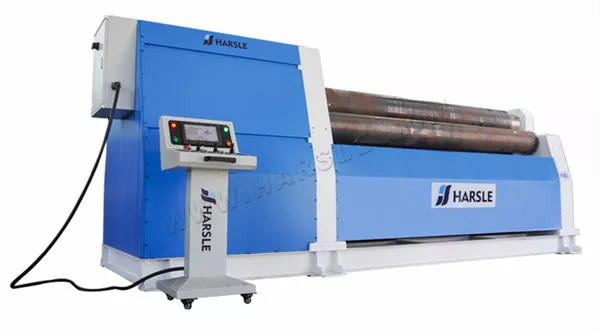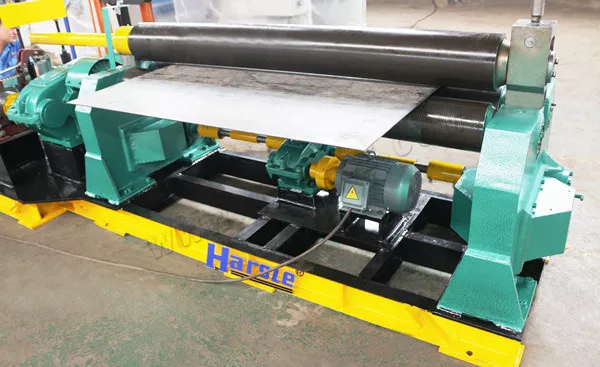What Is Metal Plate Rolling Machine

Metal Plate Rolling Machine
Metal Plate rolling machine also known as roll bending machines, are machines used to form and bend large metal plates and sheets into various shapes, such as cylinders, cones, and arcs. They are commonly used in the metalworking industry for the fabrication of tanks, pressure vessels, pipes, and other cylindrical or conical components. Plate rolling machines come in various sizes and types, ranging from small hand-operated machines to large, fully automated machines used in heavy industries.
A rolling machine, also known as a rolling mill or a roller press, is a device that uses a pair of cylindrical rollers to shape or flatten metal or other materials. Rolling machines can be manual or automated and come in various sizes depending on the application.
The basic operation of a rolling machine involves feeding the material between the rollers, which rotate in opposite directions. As the material passes through the rollers, it is compressed and flattened into the desired shape or thickness. Depending on the type of rolling machine, additional processes such as cutting, shaping, or surface finishing may also be performed.
Rolling machines are used in a wide variety of industries, including metalworking, papermaking, and plastics manufacturing. They can be used to produce everything from sheet metal for car bodies to paper for books and magazines. Rolling machines can also be used in the production of jewelry, where they are used to shape precious metals into intricate designs.
Overall, rolling machines are a versatile and essential tool for many manufacturing processes, allowing for precise shaping and manipulation of materials.

Metal Plate rolling machines work by applying force to a metal plate or sheet to bend it into a desired shape. The machine consists of three rollers, which are arranged in a pyramid formation. The top roller is the largest and can be adjusted to vary the distance between it and the bottom two rollers, which are smaller in size. The metal plate or sheet is placed between the rollers and fed through the machine until it is shaped into the desired form.
Metal Plate rolling machines can be classified into three main types based on their structure and operating mechanism: mechanical, hydraulic, and CNC.

Mechanical Plate Rolling Machines
Mechanical plate rolling machines are the simplest and most basic type of plate rolling machine. They are operated by a hand crank or a motor that drives the rollers through a gear system. The machine relies on the operator’s skill and experience to adjust the rollers and control the bending process.
Mechanical plate rolling machines are best suited for small-scale applications and simple shapes. They are relatively inexpensive and easy to maintain, but they have limited capacity and cannot handle thick or hard materials.

Hydraulic Plate Rolling Machines
Hydraulic plate rolling machines use hydraulic pressure to control the bending process. They have a hydraulic cylinder that applies force to the top roller, which in turn compresses the metal plate or sheet between the rollers. The hydraulic system allows for precise and consistent control of the bending process, making it suitable for complex shapes and heavy-duty applications.
Hydraulic plate rolling machines come in two main types: 3-roll and 4-roll. The 3-roll machine has one fixed bottom roller and two adjustable top rollers, while the 4-roll machine has two fixed bottom rollers and two adjustable top rollers. The 4-roll machine is more advanced and versatile than the 3-roll machine, as it can handle thicker and harder materials and requires less pre-bending.

CNC Plate Rolling Machines
CNC (Computer Numerical Control) plate rolling machines are the most advanced and automated type of plate rolling machine. They use computer software to control the rollers and automate the bending process, eliminating the need for manual adjustments and reducing the risk of errors and accidents.
CNC plate rolling machines come in various configurations, including 3-roll, 4-roll, and pyramid types. They are capable of handling complex shapes and high-precision work, making them ideal for large-scale production and specialized applications.

Advantages of Metal Plate Rolling Machines
Plate rolling machines offer several advantages over other metalworking machines, such as shearing, bending, and punching machines. Some of these advantages include:
1. Versatility:
Plate rolling machines can form a wide range of shapes, including cylinders, cones, and arcs. They can also handle different types of materials, such as steel, aluminum, and copper.

2. Accuracy:
Plate rolling machines can produce precise and consistent bends, ensuring the quality and integrity of the finished product.

3. Efficiency:
Plate rolling machines can bend large plates and sheets in a single pass, reducing the number of operations and increasing productivity.

4. Cost-effectiveness:
Plate rolling machines can be used for a wide range of applications, from small-scale projects to large industrial applications, making them a cost-effective investment for metalworking businesses.















